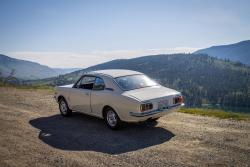 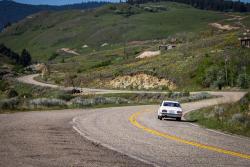 1972 Honda 1300 Coupe 7. Click image to enlarge |
Review and photos by Brendan McAleer
Mr. Ferrari. Mr. Lamborghini. Mr. Ford. Mr. Porsche. Mr. Honda. If the modern automobile industry is now a mass of corporate Powerpoint presentations promising a 15.3-percent increase in dynamism, it once was a battleground between kings.
A feud between the first two gents started one of the best-loved supercar companies on the planet. Mr. Ford mobilized the world and had a large hand in creating the middle class. Mr. Honda? Well, that’s the story of one man’s dream.
And here it is, basking in the already warming air of an Okanagan sunrise. This little coupe might be a bit obscure, but it’s the last car Soichiro Honda ever touched personally – it is, in effect, the last true Honda.
However, just before we delve into the glorious weirdness of a front-wheel-drive air-cooled machine with no sideview mirrors, a word or two on the great man himself. Unlike Toyota or Nissan, the Honda motor company wasn’t a corporation struggling to evolve from a remanufacturer of slightly horrible British saloon-cars, but rather the brainchild of a guy who had a bit of a temper. Forget everything you once thought about the buttoned-down Japanese businessman: Soichiro Honda was a certifiable nut.
Born to a blacksmith father and a weaver mother in the shadow of Mount Fuji, Honda’s first forays into engineering included inventing a stamp to forge his parents’ signatures on poor report cards. When he left school, at the age of fifteen, he went to work at a garage in Tokyo, where he helped build racing cars. His mechanical aptitude, honed by hours working alongside his father at the forge, helped him impress his boss, and they were soon coming up with stuff like a lightweight racer powered by the engine out of a biplane. Yes, really.
This raw creativity is key to understanding what made those early Hondas so special. Where other engineers followed a clear-cut path through traditional education, Soichiro simply went out and built stuff. He worked as a racing mechanic, did a little driving himself, and eventually suffered both a devastating crash and a humiliating rejection of his work.
This work, an obsessive effort to come up with a new type of piston ring, forced Honda to re-evaluate and pushed him back to school. He blazed through the coursework with a burn-the-candles-at-both-ends attitude, and was soon back in business. Then came the war and the US Air Force’s Superfortresses bombed his factory into the ground.
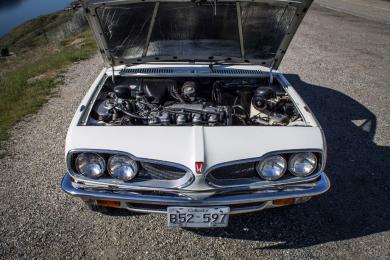 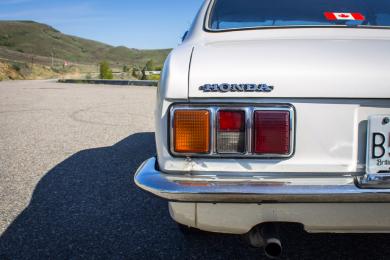 1972 Honda 1300 Coupe 7 engine bay & taillight. Click image to enlarge |
At this point, an ordinary person would have retired, perhaps setting up a small bicycle repair shop, and opting for a quiet life. Mr. Honda converted war-surplus military-spec generators originally intended for field radios to run on pressed fir oil and attached them to bikes, creating flatulent little mopeds that helped Japan get back on wheels again. A little while after that he invented Honda’s first motorcycle, and then its first proper passenger car.
This is that car. Preceded by tiny, chain-driven microcars, the Honda 1300 was the first real Honda car. In a way, it would also be the last.
Rare enough that you’ve likely never heard of it, this machine was only ever sold in Japan and a few overseas markets, most notably Australia. It had quite a following there, and that’s where this car’s current owner found it – sitting on stage at the Melbourne Auto Show.
In the early 1970s, Lindsay Thachuk was a teacher in the South of Australia, and he was fed up with his Austin Mini. While the diminutive little machine was a delight in the corners, first you had to get to the corners, and that wasn’t always so easy in a machine built to “that’ll-do” British quality control. It broke. A lot.
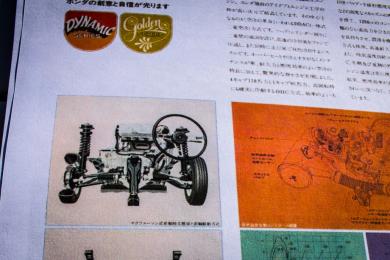 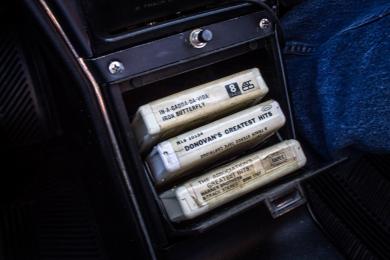 1972 Honda 1300 Coupe 7 design & 8-track storage. Click image to enlarge |
While it was in the shop for a particularly egregious failure, Thachuk went shopping and ended up with his Honda. He originally wanted a grey one but ended up with the white car after a delivery issue – luckily, as it turns out, as the merciless Australian sun was hellish on early clearcoats in any shade darker than white.
Looking at the nose of this car, I hardly need pass on that Soichiro owned a Pontiac Firebird and could be seen driving it all over Japan. The sweeping lines of the Honda look a bit like a contemporary Datsun, but the nose is pure Detroit beak. Apart from the bright red Honda badge, of course.
It wasn’t the fast one. Honda made two versions of this car, with the Coupe 9 coming with a quad-carbureted engine cranking out 113 hp. Not much by modern standards, but we’re talking about 1300cc of displacement and forty years ago. The single-carb version made a still-healthy 96 hp, and the car weighed next to nothing.
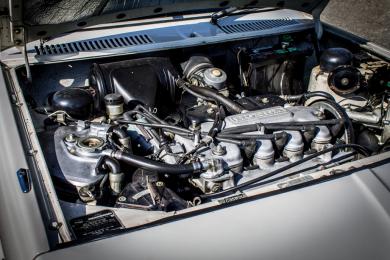 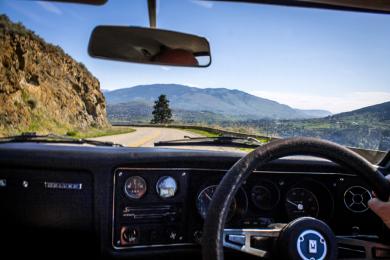 1972 Honda 1300 Coupe 7 engine bay & dashboard. Click image to enlarge |
Speaking of modern standards, the little Honda 1300 had the following: front disc brakes, fully independent suspension, rack-and-pinion steering, an electric fuel pump, and it was front-wheel-drive in an era of rear-drive machines. All of these features were very advanced for its time, and the combination of advanced suspension, low curb weight, and revvy engine would become hallmarks of all the best Hondas.
And then there was all the weird stuff. First, the 1300’s all-aluminum engine was air-cooled. Here’s a list of every air-cooled, front-engine, front-wheel-drive machine ever made:
– Honda 1300
– Citroën 2CV
– …
– *crickets*
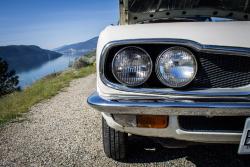 1972 Honda 1300 Coupe 7 headlight. Click image to enlarge |
So, just as odd as a French car, but built to a bulletproof standard, and with power levels that had Toyota’s engineers green with envy. Thachuk’s little Honda was also incredibly economical – he produces a notebook he kept tracking fuel and maintenance, and notes both stellar fuel-consumption and service bills that were little more than a basic oil-change.
When he moved back to Canada, Thachuk looked at selling his Honda, but something stopped him. A friend suggested that finding space in a shipping container would be easy enough, and after a long sea voyage, the little Honda rolled onto Canadian soil. It remains one of only two such cars in the country, one of only three 1300s in all of North America, and is likely the only single-owner Coupe 7 in the entire world. “Like to take it for a drive?” You betcha’!
Those Japanese home market fender mirrors had to be removed for pedestrian safety reasons, so there’s not much adjustment to be done other than cocking the rearview and scooting the seat back. The Honda’s interior has that excellent 1970s cologne of vinyl and plastic. Every generation of car has its own smell, and this isn’t that far off the whiff of an MGB or an old Chrysler land yacht.
It drives far more like the former than the latter. Light on its feet, the Coupe scurries through the curves with a deftness that has a grin creeping across my face. If you’re a Honda fan, this is where it all began. The effortless steering, the easy composure; a dancing chassis paired to a singing engine. The quicker versions of this car actually had some racing success at Bathurst, where they diced it up at high speed with fast Fords and the like. Because the 1300 was so stable at speed, even with those skinny tires, it held its own against more powerful machinery.
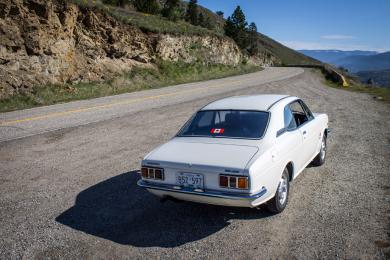 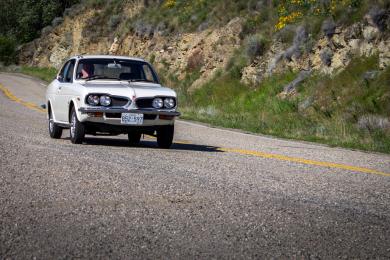 1972 Honda 1300 Coupe 7. Click image to enlarge |
Old cars can often be a bit alarming to drive, but despite the all-original nature of this machine, it’s a sparkling delight. It doesn’t get much use these days, and a spin down this old stretch of former highway is about as much exercise as it’s had in months. Thachuk uses it for brief runs about town, but because parts are nigh-on impossible to come by, he doesn’t risk it on longer journeys.
And that’s as good a point as any to return to some sad reality. The 1300 wasn’t a success at all – in fact, it was something of a financial boondoggle. Honda lost his temper at the engineering staff frequently, and kept backing up the production line as he thought of some other feature he wanted to introduce. It was never quite good enough, and the endless delays and complete reversal of the assembly line nearly bankrupted the company.
|
Related Articles: Manufacturer’s Website: Photo Gallery: |
After the 1300, Honda stepped back and his engineers produced the Civic. A far more pragmatic vehicle, the Civic is probably the first vehicle that pops into anyone’s head when they hear the word “Honda”. It was a huge success for the company, of course, and gave rise to a huge fanbase.
The 1300 is something else, an odd little misfit of a car, but one that is infused with the foreshadowing of greatness. It’s a bit of a hodgepodge of futuristic ideas, but you can sort of see it hinting at the audacity of cars like the Acura NSX, or the engines that would power Senna to victory in the McLaren-Hondas.
Audacious. Audacious is the word. If Honda is struggling a bit with dialing a bit of innovation back into some of their everyday products, they need look back as well as forward.
This scrappy little 96-hp 1970s coupe embodies the very soul of Honda’s founder. Dream big. Demand excellence. Always keep striving. A lesson any automaker could take to heart and maybe, too, a lesson for us all.











